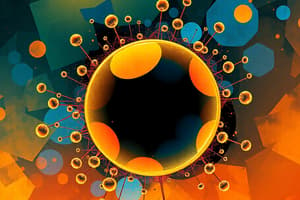Podcast
Questions and Answers
Who is credited with describing molecular machines capable of building structures with atomic precision?
Who is credited with describing molecular machines capable of building structures with atomic precision?
- Norio Taniguchi
- Richard Feynman (correct)
- An unnamed scientist
- A team of researchers
What is the term for the approach where the material 'creates itself'?
What is the term for the approach where the material 'creates itself'?
- Micro-approach
- Nano-approach
- Bottom-up approach (correct)
- Top-down approach
What is the focus of nanoscience?
What is the focus of nanoscience?
- Developing technology to manipulate individual atoms and molecules
- Designing new materials for industrial applications
- Studying the properties of materials at the macro scale
- Investigating the phenomena, properties, and responses of materials at the atomic, molecular, and macromolecular scales (correct)
What is the application of nanoscale titanium dioxide photocatalysis?
What is the application of nanoscale titanium dioxide photocatalysis?
What is the purpose of dendrimers in nanotechnology?
What is the purpose of dendrimers in nanotechnology?
What are nanocomposites made up of?
What are nanocomposites made up of?
Who coined the term 'nanotechnology' in 1974?
Who coined the term 'nanotechnology' in 1974?
What is the application of nanofilms in thin films?
What is the application of nanofilms in thin films?
What is the difference between the top-down and bottom-up approaches in nanotechnology?
What is the difference between the top-down and bottom-up approaches in nanotechnology?
What is the potential application of nanoparticles of anatase titanium dioxide?
What is the potential application of nanoparticles of anatase titanium dioxide?
Flashcards
Molecular Machines
Molecular Machines
Structures capable of building things with exact atomic positioning
Bottom-up Approach
Bottom-up Approach
Materials created by assembling molecules, like building a complex structure piece by piece
Nanoscience Focus
Nanoscience Focus
Studying materials at the atomic/molecular level
TiO2 Photocatalysis
TiO2 Photocatalysis
Signup and view all the flashcards
Dendrimers in Nanotechnology
Dendrimers in Nanotechnology
Signup and view all the flashcards
Nanocomposites
Nanocomposites
Signup and view all the flashcards
'Nanotechnology' term coined by
'Nanotechnology' term coined by
Signup and view all the flashcards
Nanofilms in Thin Films
Nanofilms in Thin Films
Signup and view all the flashcards
Top-down vs. Bottom-up
Top-down vs. Bottom-up
Signup and view all the flashcards
Anatase TiO2 Nanoparticles
Anatase TiO2 Nanoparticles
Signup and view all the flashcards
Study Notes
Richard Feynman and Molecular Machines
- Richard Feynman described molecular machines that can construct structures with atomic precision, highlighting the potential of nanoscale engineering.
Nanoscience and Nanotechnology
- Nanoscience: Examines the properties and behaviors of materials at atomic, molecular, and macromolecular levels.
- Nanotechnology: Focuses on technology that operates at dimensions below 100 nanometers, emphasizing the manipulation of individual atoms and molecules.
- The term "nanotechnology" was coined by Norio Taniguchi in 1974.
Approaches in Nanotechnology
- Top-down approach: Involves miniaturization in the electronics sector, transitioning from microelectronics to nanoelectronics.
- Bottom-up approach: Materials are created through self-assembly, exemplified by the chemical synthesis of thin polymer fibers.
Dendrimers
- Dendrimers are engineered nanostructures capable of carrying various materials for medical applications.
- These structures can recognize diseased cells, aid in diagnostics, deliver pharmaceuticals, and report therapeutic outcomes.
Nanocomposites
- Nanocomposites consist of nanoparticles assembled molecule by molecule, enhancing properties and functionalities of materials.
Nanoscale Titanium Dioxide Photocatalysis
- Nanoscale titanium dioxide exhibits antibacterial properties applicable to air and water purification, anti-fogging, and self-cleaning surfaces.
- Anatase titanium dioxide nanoparticles effectively eliminate harmful air pollutants, contributing to environmental health.
Nanofilms
- Nanofilms applied to surfaces create features such as water repellency, anti-reflective properties, UV and infrared resistance, and scratch resistance.
- Common applications include coatings for eyeglasses, computer monitors, and camera surfaces, enhancing durability and functionality.
Studying That Suits You
Use AI to generate personalized quizzes and flashcards to suit your learning preferences.




